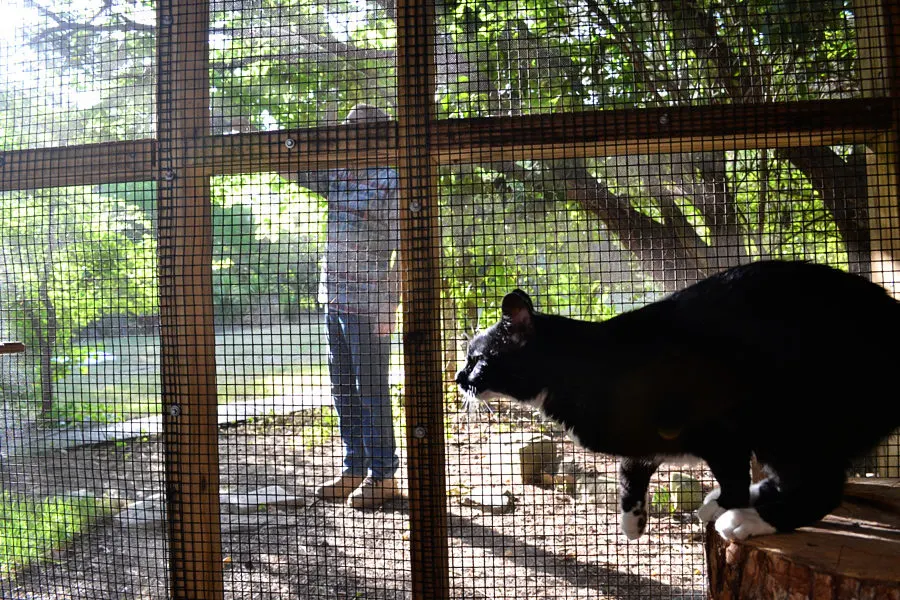Have you decided you’d like to build a catio? A few years ago, we decided that we’d like to add a cat enclosure to our house so our cats could safely enjoy the outdoors. We drew up some simple plans, shopped for materials and built a catio onto our home in about a week’s time. Come along and we’ll show you, step by step, our process!
Drawing Up Our Plans
Before we started, we circled our home to decide in which area we’d like to add the catio.
Because of the many coyotes in our area, we decided that the catio should be within the confines of our fenced front yard, so we don’t have to worry about a skunk or coyote wandering up, which would be a concern in the side yards or the back yard. The fence isn’t tall enough to absolutely keep the coyotes out if they really wanted in, but thankfully they have stayed out of it. This area is also patrolled by our dogs whenever they’re outside.
This location also has shade and sun, depending on the time of the day, both important for the catio so that it can be used year around in our fairly temperate climate.
We drew up a plan for a simple catio that had access through a window in our storage room.Although there are some great DIY catio plans available for purchase online, we drew up our own simple plans with an exterior door so that we can get inside the catio for cleaning.
Preparing the Location
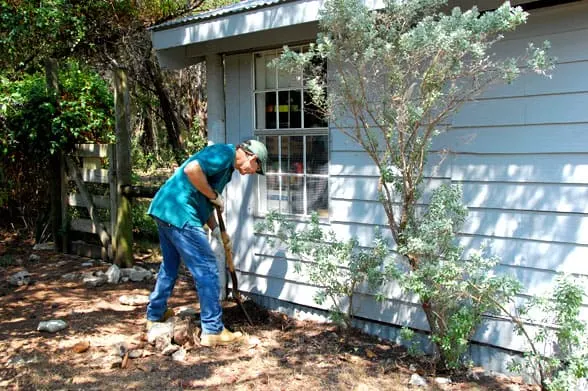
After bringing down a nest of wasps in the eves of the house, John started work on the catio by first removing the purple sage bushes that were growing at the side of the house. (I missed the removal of the first bush; John took it out during the dog walk.)
They’re great bushes for our hot, dry weather but they were in the way of the catio window. I attended a Forest Service meeting about wildfire danger (we were in a terrible drought during catio construction) and these were on the list of flammable plants that you should keep away from your home. John dug them up and moved them further away from the house.
By the end of the morning, the bushes were gone:

As you can see, the window looks out on a large juniper tree where we have several bird feeders, extra enrichment for the cats! The gate in the photo leads out of the yard so the catio doesn’t extend past the house so there’s no contact between the cats and whatever wildlife might wander up.
Purchasing Catio Building Materials
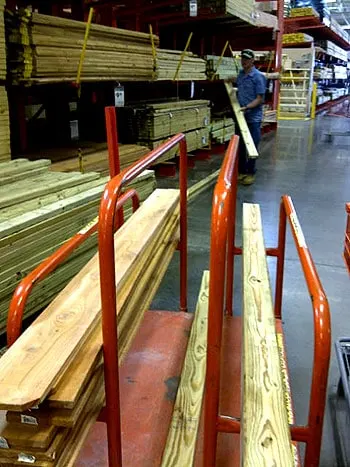
Once the site was prepared, we headed to Home Depot to purchase almost all the materials for the catio. John earlier bought 4×4 posts, and we later purchased fine screening to keep mosquitoes out of the catio.
We first purchased pressure treated 2x4s for framing then we bought cedar pickets for the flooring and the roof.
We were originally going to buy pine but the price of $1.17 a board on the cedar pickets was just too good to pass up. We quickly did some refiguring for our plan to figure the number of pickets we’d need:
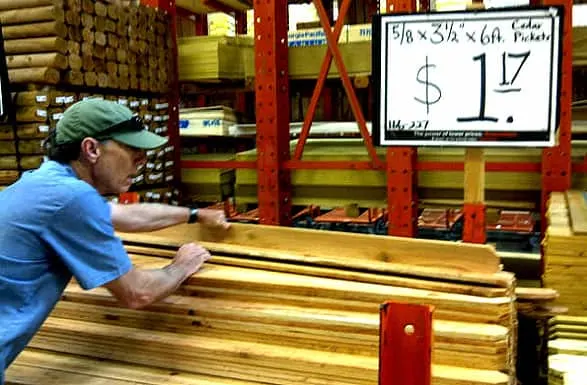
The ends of the boards were notched (because they’re intended to be fence planks) so we lost about an inch off the end of the flooring but we were able to incorporate the notches into the roofline, which looked interesting:
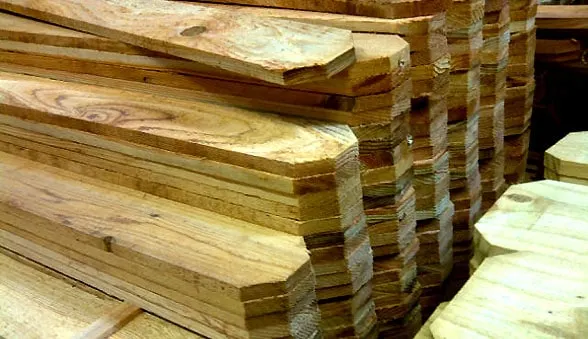
Once we had the lumber selected, we headed out to the garden center where they keep the hardware cloth.
Hardware cloth is heavy-duty aluminum screening with larger openings than window screening. We used the hardware cloth in the interior of the catio; the regular window screening to keep out mosquitoes and other bugs went on the outside of the catio, safe from the cats’ claws.
You’ll find several sizes of hardware cloth. We wanted either green or black hardware cloth (you can also spray paint hardware cloth but that’s a big job and another expense).
We found regular aluminum hardware cloth that’s been dipped in green vinyl:
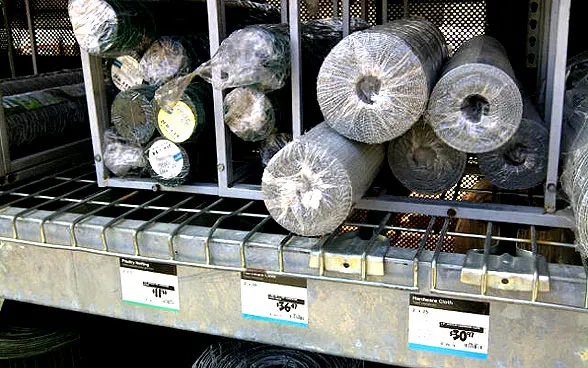
By the time we got home from the store, it was well into the 90s so we parked the pickup in the shade to prevent the boards from warping. The next day, catio construction began!
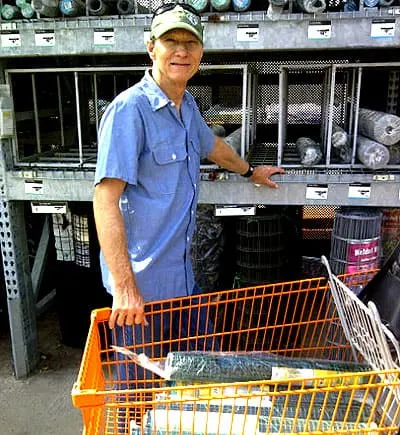
Catio Construction, Day One
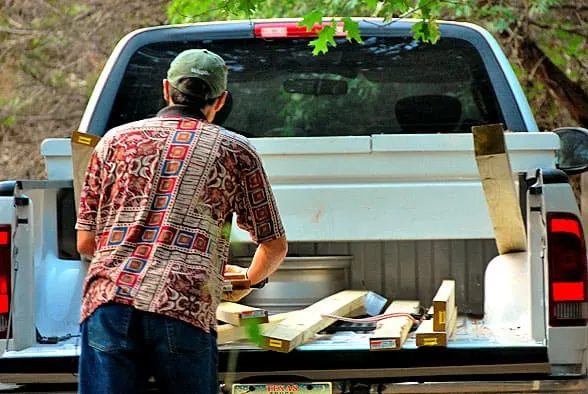
With yet another 100 degree day predicted, we started work early on the catio! The first step was to unload the materials that we’d had parked in the carport overnight.
Then it was time for the real work to begin. John has done a lot of building projects around here (most of our house, the garage, the barn, the workshop, the pumphouses) but this was his first catio!
We’ve had lots of idea on the design of the catio to stay within our budget but still have a catio that somewhat matched the rest of our house. So that we didn’t have to worry about supporting the weight of the structure, John decided to build it using posts for support. That meant the first real step was locating the placement of the posts:
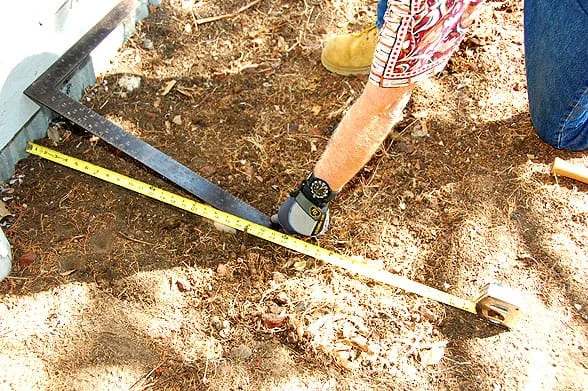
The catio will be three feet deep and six feet long. Its roof follows the roofline of the room it’s attached to (a storeroom), and the window of the storeroom became the entrance for the cats to enter the catio (via a cat door installed in the window).
Once the corners were located, John started the tough work of digging the post holes…
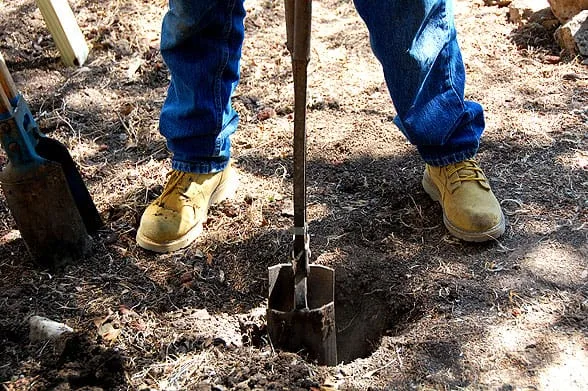
…as Tiki watched from the front porch):
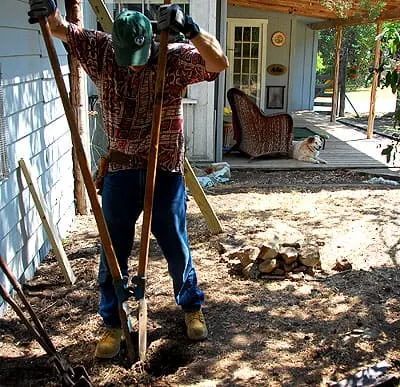
Over the next few hours, the posts were in place, squared and leveled. The ledger board was nailed to the house then the boards for the joist were cut…
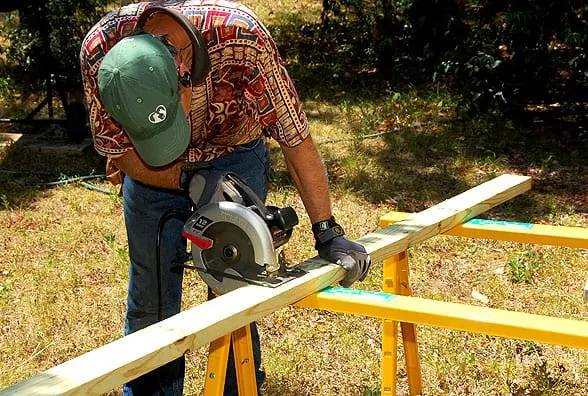
It started to take shape!
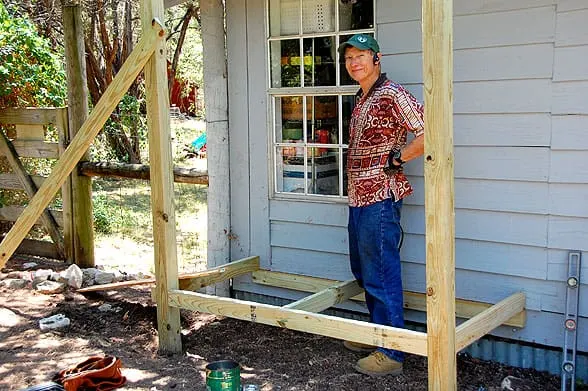
The next step will be to staple screening across the joists (to keep mosquitoes from coming up through the floor if it ages and forms cracks between the boards). The flooring will go in next.
Catio Construction, Day Two
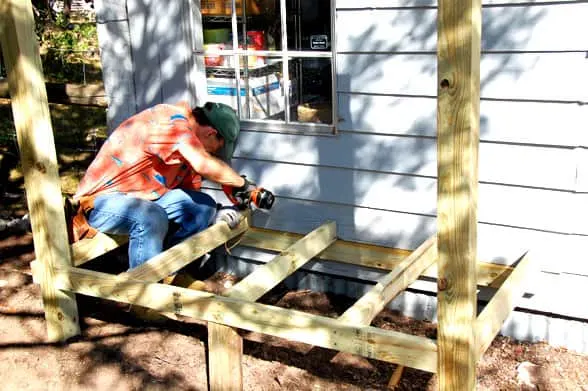
Next, John added a couple of additional joists and a center brace so the floor is nice and sturdy (although our cats aren’t that heavy.) We need to be able to walk on the catio floor, too, though, to clean.
Soon it was time to put down insect screening to prevent any bugs from coming up between the floorboards:
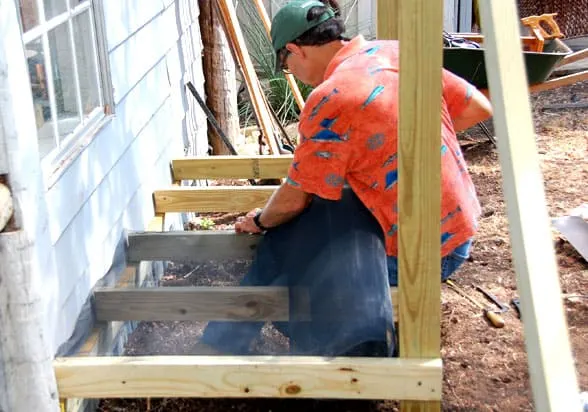
We purchased a roll of screen for the job because we didn’t have any scrap on hand but, if you have some old screen, that would work just as well because this screen won’t be visible (unless you crawl under the catio).
Once it was in place, John pulled it tight and stapled it in place to prevent any bugs from working their way in:
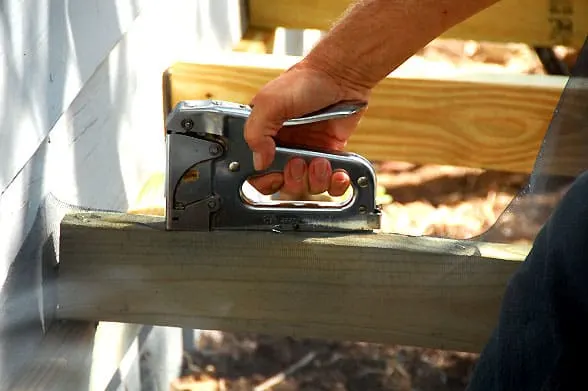
Next it was time for the flooring! We used cedar pickets used for fencing; they’ll stand up good against any rain that blows in the catio:
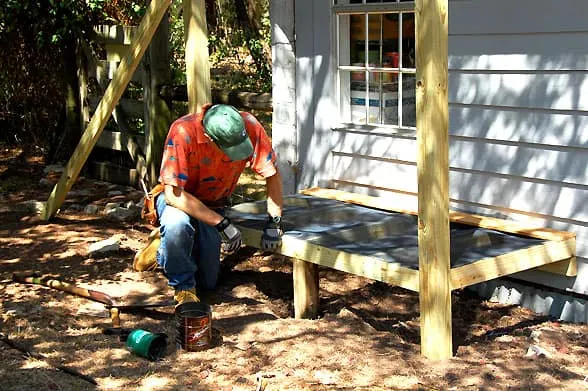
As we were working, a little visitor came by to check out the work.
High up in the tree, this chicken snake decided to see what was happening:
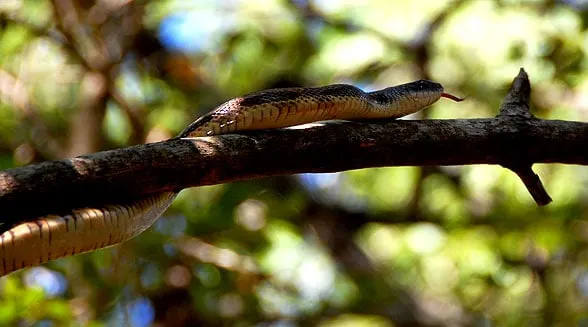
He was a good reminder to us that the catio construction had to be tight to keep out any creepy crawlies!
Next, the flooring went really quickly except for the notching of the boards to fit around the two corner posts:
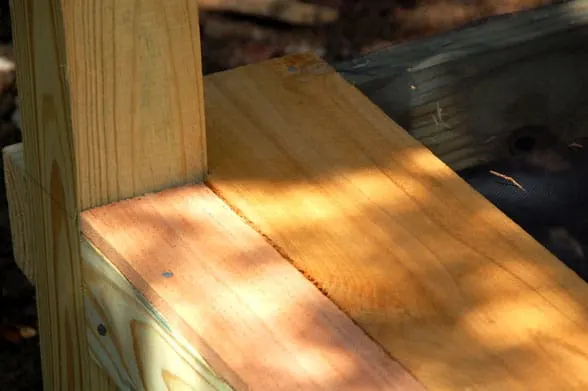
The boards were trimmed:
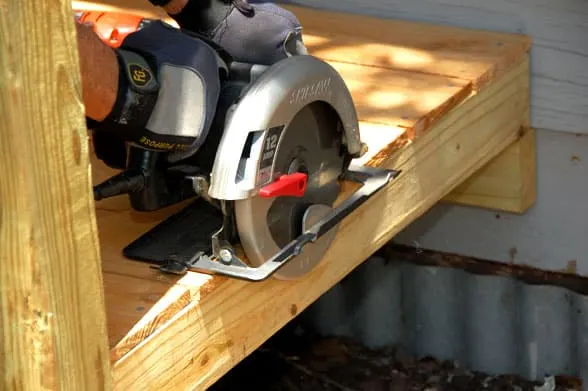
And then Day 2 construction was done. Day 2’s work was just half a day because the temperature had reached 100 degrees by 1pm!
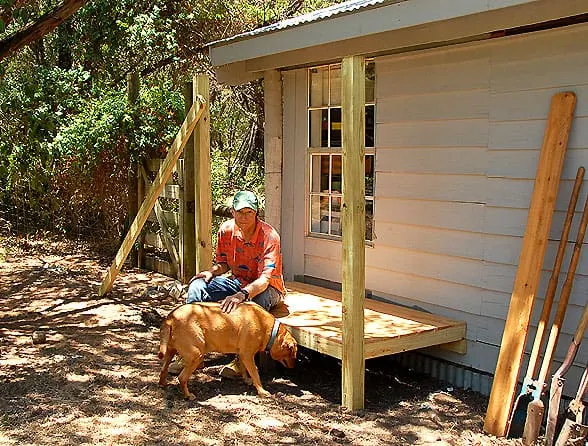
Catio Construction, Days 3 & 4
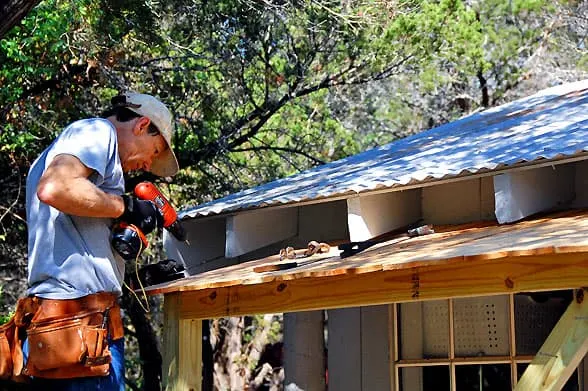
You know how a cat slooowly creeps up on something before pouncing?
Well, that’s about the pace the catio construction went for the next two days! Temperatures were hitting ridiculous levels (106!) so construction was whittled down to just a couple of hours in the morning.
John completed the roof construction and then added the vertical studs that the screen and hardware cloth will attach to. After that was in place, the next step was closing off the triangle between the catio roofline and the screening.
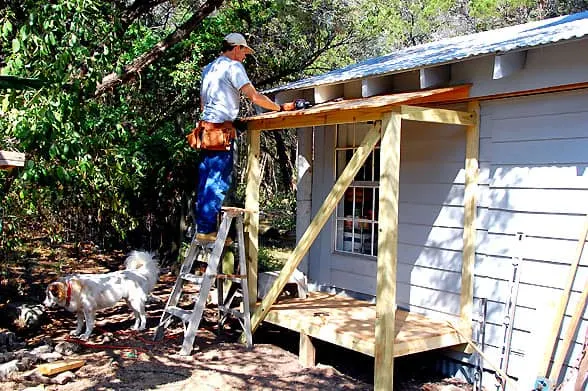
Shopping for Catio Furniture
While John was constructing the catio, I selected cat furniture for the catio. (OK, I realize that’s not quite a fair trade!)
Since all the budget went to catio materials, I looked around and see what we could repurpose or buy used.
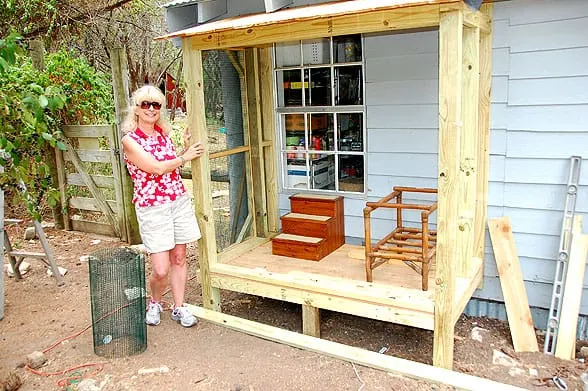
I settled on two pieces of furniture so far, both ones that we already had on hand. Both originally came from the thrift store.
The first was a set of children’s steps that absolutely fit *perfectly* beneath the window where the cat door is! I’d purchased the steps a while back for $5 because they have great storage inside (each carpeted step can be lifted off). We’ll glue each step in place so it doesn’t come loose as a cat goes in or out but the height is just the perfect fit beneath the window which provides access to the catio.
The second piece of furniture was a repurposed bamboo coffee table. I bought the coffee table at the thrift store last summer to use as patio furniture. Unfortunately, the top came apart in the weather but we had kept the frame itself (being bamboo, it’s pretty tough). Later John took some of the scrap cedar boards left over from the catio roof and made a top to the table–sort of a cat bunk bed!
Catio Construction, Days 5 & 6
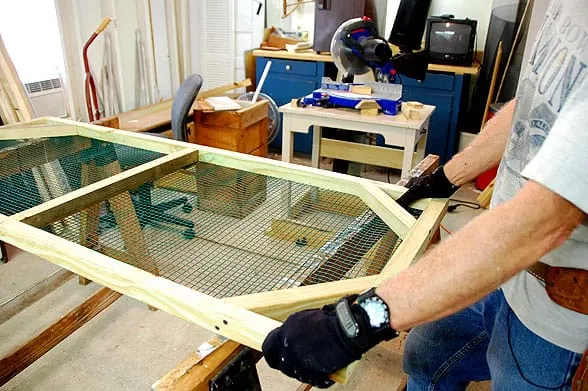
John built a door for the catio so we’d be able to go in and clean out the catio as needed.
He covered the inside of the door with hardware cloth. The hardware cloth we selected is aluminum dipped in green vinyl so it won’t be quite as noticeable as shiny aluminum hardware cloth.
He stapled the hardware cloth to one side of the door…
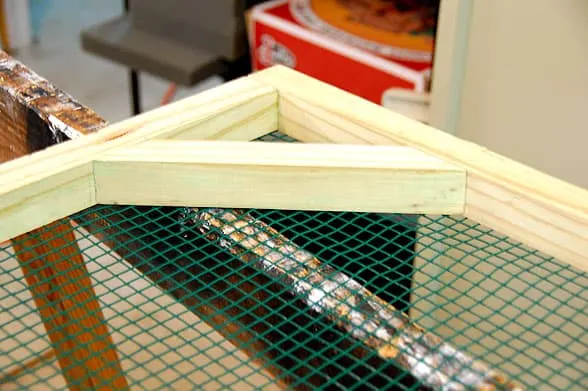
…then rolled out insect screening on the other side of the door…
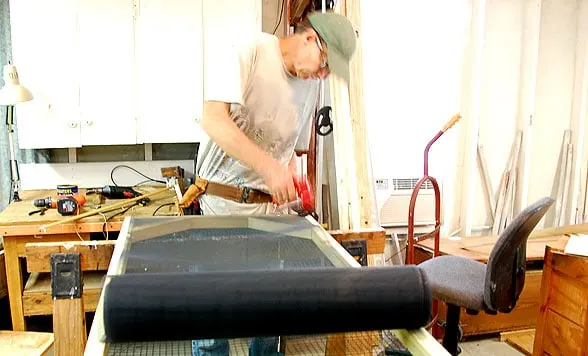
We did the same for the entire catio with the hardware cloth inside and the finer (and more fragile) insect screen outside and away from the cats’ claws.
Soon it was time to brave the heat and hang the catio door:
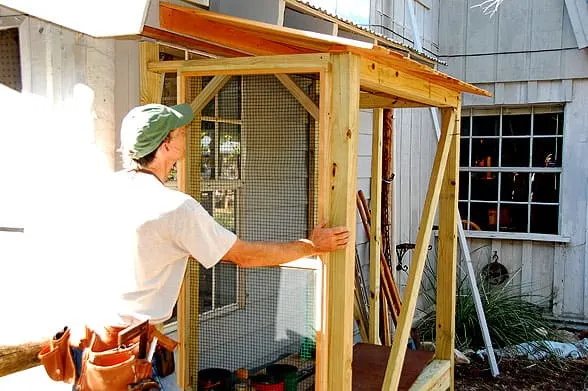
Before sealing off the small triangle above the door, John stapled insect screening beneath the roof to keep out any bugs:
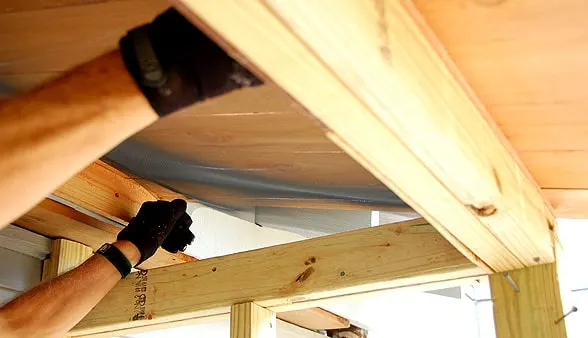
Next will come the screening for the front and the other side and the closing off of the roofline triangles on both sides. The end was in sight!
We Have a Catio!
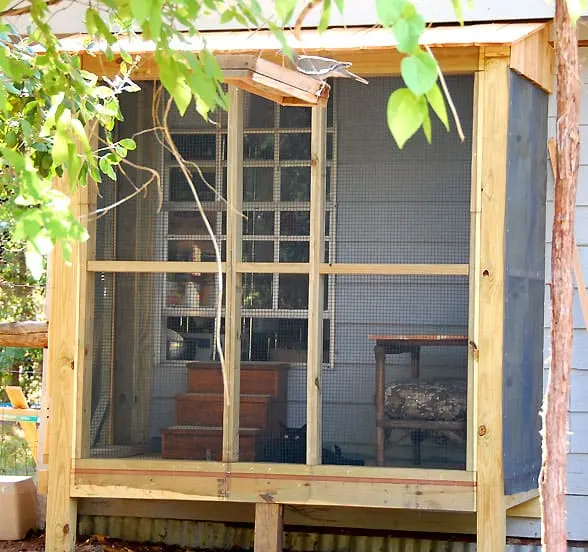
Yes, we finally have a catio!! After hanging the rest of the insect screening, we finally, finally got the catio opened for business!
As we suspected, Inca was our first occupant! Ever since we adopted her, Inca has wanted to go outdoors, something just impossible out here due to coyotes.
With the opening of the catio, Inca finally got outdoors!! As soon as she stepped out (through the open storeroom window which soon will contain a cat door), some birds showed up at the bird feeder. Inca couldn’t have been happier. Soon she was joined by Felix, Linus, and Coco.
Adding a Catio Door
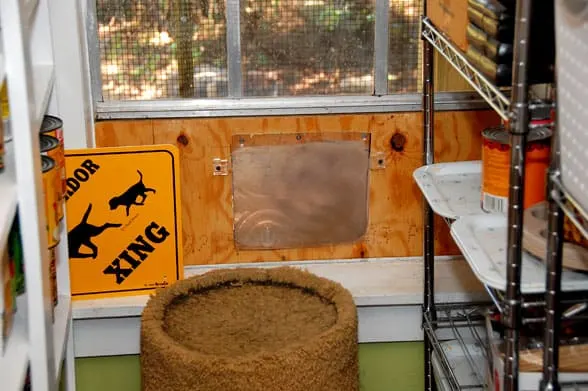
The first day we opened the catio to the cats, we just partly raised the window in our storeroom to allow them access. However, with a hot summer weather, we knew that we couldn’t continue to leave the window open and air condition the great outdoors.
We thought about purchasing a cat door but decided to go the homemade route. We have a homemade cat door leading out to our laundry room (where the litter boxes reside) so we figured the cats would quickly adjust to the same arrangement here. We were right.
John cut a piece of 3/4-inch plywood the width of the window. He also cut an opening in the plywood the size of a large cat flap then smoothed the edges with sandpaper. The plywood fits into the window track and is held in place by the window itself. (Later we painted the plywood white to match the wood trim on the window.)
The flap is a piece of vinyl carpet protector trimmed just a tiny bit narrower than the door itself.
Two brackets (sold to hold mirrored glass in place) are located on the sides of the cat flap; this allows us to slide the “Labrador Xing” sign (above in the photo) into place if we need to close the cat door.
This allows us to close the catio access to the cats so we can go outside and open the hinged human door to get access for cleaning or working on the catio ourselves.
Within hours of the new cat door being put in place, our four cats were back in the catio enjoying the outdoors.
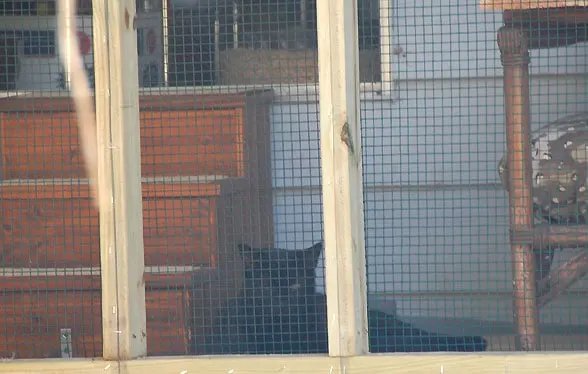
Adding Some Final Touches

Although we’d had the catio fully functional for a couple of weeks, we still had some final details to do in terms of trim.
First, John added flashing between the house roof and the catio roof to protect the seam from leaks:
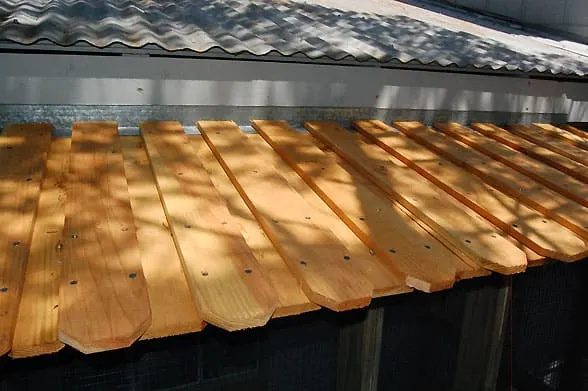
Then, he added a second layer of roof boards, staggering the second layer to cover the seams of the first layer of boards to keep out rain:
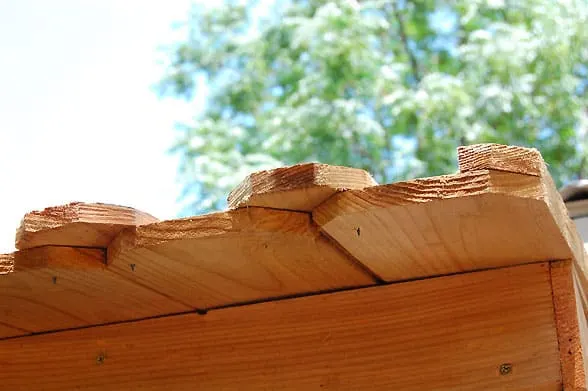
He also added trim to seal the seams where the catio joins the catio roof and the house. (There’s a layer of insect screening inside the catio at these seams so they’re more aesthetic than practical.)
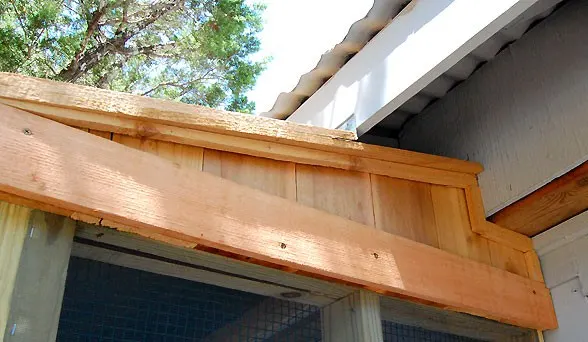
All in all, Inca says this job is done!

Catio Accessories
Through time, we’ve added accessories to our catio to give the cats a chance to climb, perch and scratch. As I mentioned above, we added a small set of steps to help the cats access the cat flap into the house. And we added a small side table that functions as a double decker bed:
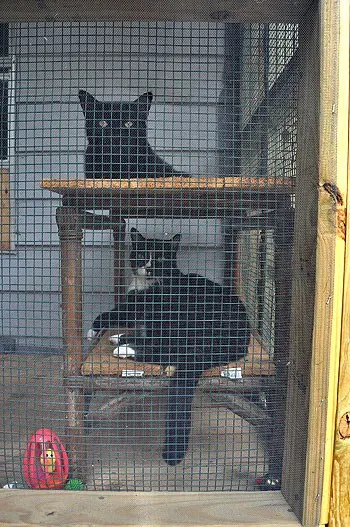
This was a former coffee table I had bought at a thrift store; John replaced the top with leftover boards after the catio construction. He also added boards to make a tabletop in the lower portion.
Later, we added a wood stump both for perching and for scratching:
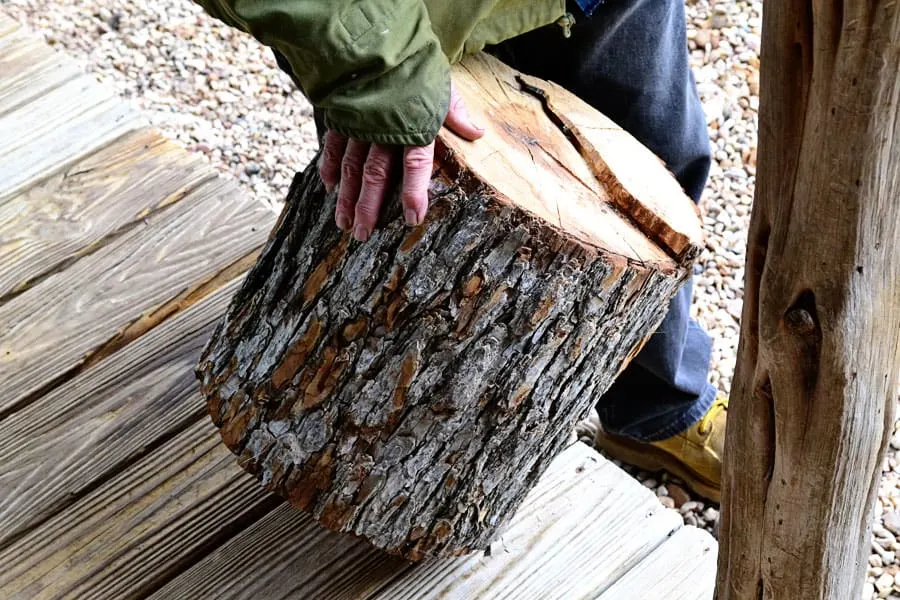
Yes, it may look like a mere elm stump…but it’s more, so much more.
My parents gave me this stump in with a load of firewood. This was from a tall elm in my parents’ backyard, one that I played beneath on many childhood afternoons. The tree died last year and had to be cut down — so I had to think of a special use for this special tree.
Less than half an hour after John put it in the catio, Inca had discovered it and proclaimed it the perfect perch for watching the bird feeder!
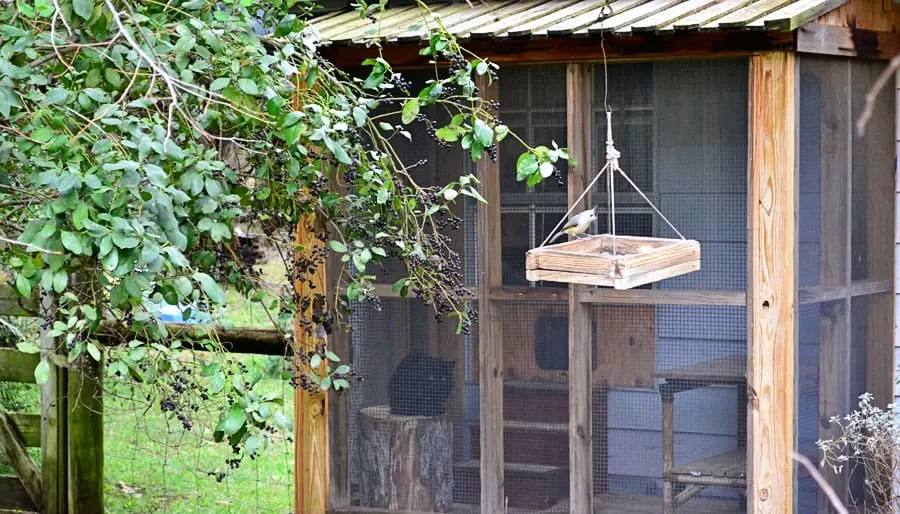
Year Around Use of the Catio
Our catio gets use year around, although it gets its heaviest use in the spring, summer and fall. (Even on our hottest days, the cats love to go outside for a nap.)
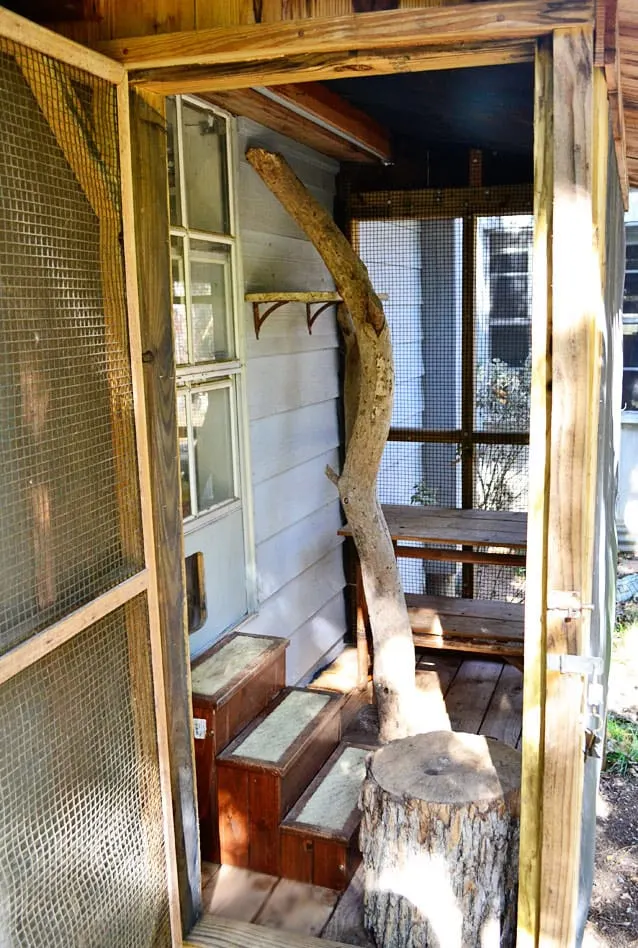
John added a tree to the catio; he mounted a dead tree to the floor and wall of the catio, adding a new shelf near the top of the tree to provide an extra special perch.
We hung two hummingbird feeders, a regular bird feeder, and a suet feeder in view, so the cats always have plenty to watch.
Our catio is now on its second generation of residents and is as wonderful as the first day we opened the catio door.
This photo of Jetty, just two days after her adoption, remains one of my favorites–she was just a little thing at just four months old!
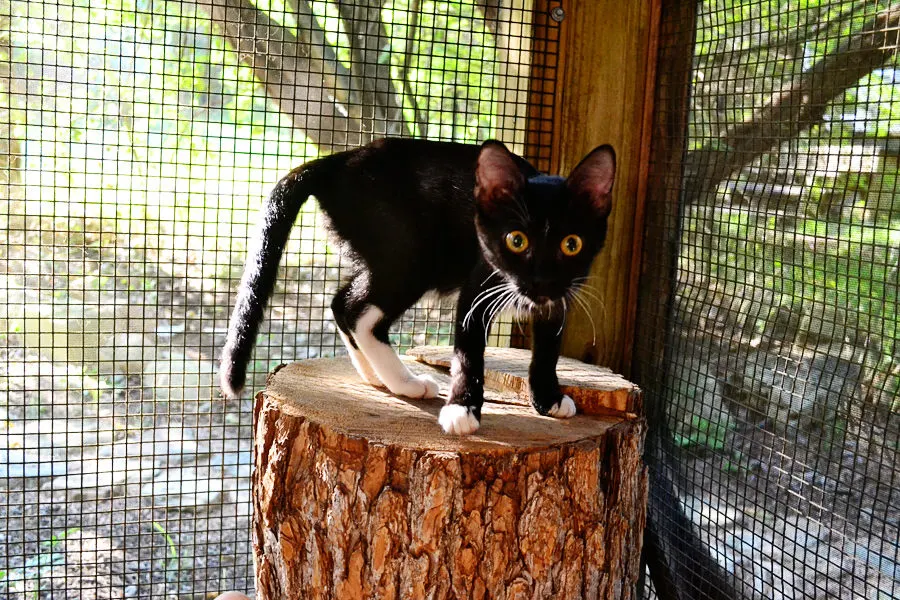
And that’s our catio! We love and our cats love it. Like a mini-screened porch, it provides the cats a way to go outdoors while staying safe (and protects local bird life as well).

